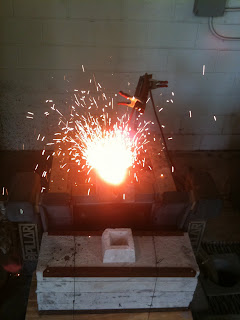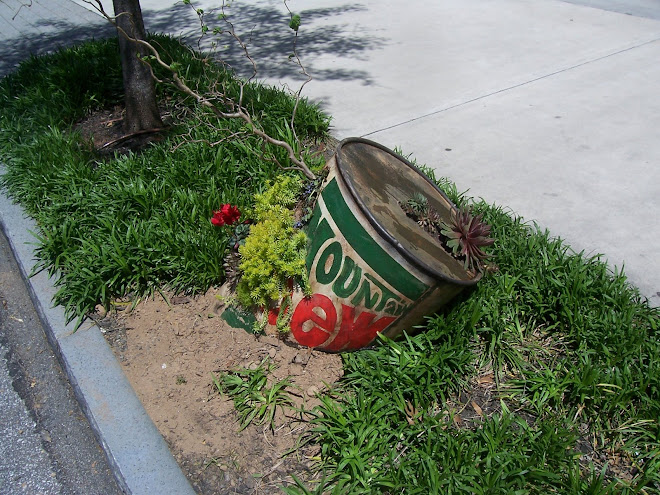



This blog is dedicated to the ongoing art work of David Fields. David is currently attending the Savannah College of Art and Design Atlanta Campus.













In my work so far, I have used primarily scrap or used parts that have been thrown away because they are worn out or defective. The majority of scrap metal is discarded or sent to a recycler to be melted down and reused as an alloy. Most of the recycling happens over seas and is sent back to the United States or around the world as saleable products. My plan is to gather metal pieces that I have had for a while and not been able to incorporate into a sculpture (“twice rejected” parts), photograph these pieces for documentation, then melt them down and cast them into ingots. These ingots will be separated into categories depending on where the metal comes from and stamped accordingly. The ingots may then be used to make cast steel sculptures or formed back into parts again to incorporate into a sculpture. Also to produce commissioned Parts or pieces made to order.
To display the process and progress of the piece, I’ll use the photo documentation, the ingots made so far, the pallet to display the ingots on, and the pedestals to raise the pallet and the photo documentation on. The photo album will be on a pedestal by itself. There will be another pedestal for the ingots display. I will construct a pallet to stack the ingots on top of the pedestal. The pedestals will be made from repurposed parts also. Also any paint or finishing products for the pieces made will be used from left over stock from previous projects.
There will not be an exact temperature that the scrap will melt at to create the ingots. The Reason is that most steel is an alloy, which means a mixture of different metals. Alloys are created to give the steel different qualities depending on what is needed. Some are made to be more corrosion resistant, some to be stronger or more heat resistant. There are too many combinations for me to go into detail about what temperatures that I could need and for what reasons. Also because of the possible extreme temperatures a standard crucible will not be sufficient and neither will a ceramic lost wax cast. I will have to use multiple cast sand molds every time I cast ingots, because the molds will be destroyed every cast from the heat. My plan is to try both green sand and bonded sand techniques for the molds. My pattern will be made from wood and be stackable, with a gating system that can be used with one or multiple sets of four. The gating system after the ingots are poured will be removed from the ingots creating an additional rejection of the metal “Three Times Rejected.” It will become it own batch “Three Times Rejected” to be stamped R3.
The pallet or pallets are to be constructed out of very nice or exotic wood. It should be very well made and pleasing to look at when standing alone but will not detract from the overall purpose of the piece. All fasteners if needed will be flush to the wood and sanded to a shinny finish. The ingots will be stacked on the pallet each layer alternating back and forth. Ingots will be marked with a stamp indicating what batch of metal they came from and the origins they are thought to be from. I will also be looking into having a metallurgical breakdown performed on some of the ingots and a copy displayed for the show.
Documentation will consist of photographing the parts to be melted down, weighing the parts to be melted, and documenting the weights of each part. I will describe the original purpose of the part if known such as car part, lawn mower part, or other and also the origin of the part. The documentation of the parts used and their photos will be assembled into a parts catalogue. Once documented and catalogued it will be assigned a batch number linked to its purpose and origin. This batch number will be included in its stamp. Hopefully this parts catalogue will grow and so will the show to include many different types of metal.
Whether a personal piece or a commissioned piece, I start all my sculptures the same. I look through all my scrap and parts to see if I see the finished piece or parts of it in what I have. If all the parts are not there, I wait till they are or until I find what I call the heart piece. The heart piece is usually the first piece I find, and it gives me the vision of the way the finished piece will look. It gives me the starting point hence, “The Heart Piece.” Sometimes the heart piece can be very small and sometimes it can make up the majority of the piece. Either way, if it is not there, the piece feels wrong. The piece might still look good to others and overall be a great piece but it will lack that small extra that pushes it over the top. Almost all of my sculptures have a heart piece and to me would not be the same without it.
My non-parts pieces usually start with a heart piece also but the entire work is made from scrap or new metals. In other words I do not use any pre-made parts such as nuts, bolts, gears or the like. Presently I am studying paint and how to apply painting techniques to my sculpture. Some pieces I like raw with no paint so you can see the joints and welds, which sometimes add more life than paint ever could. Other times the paint is the heart piece and without it the piece is just undone.









